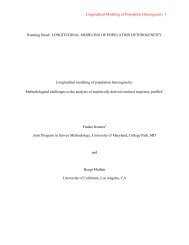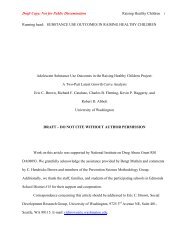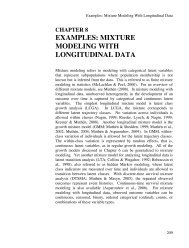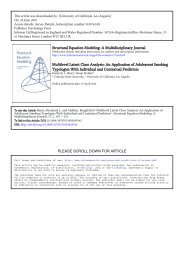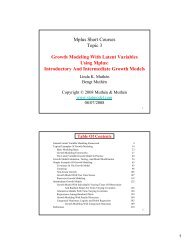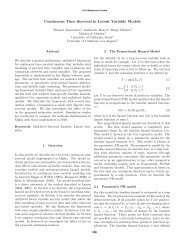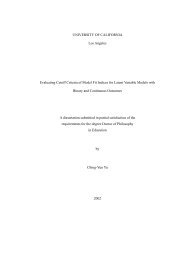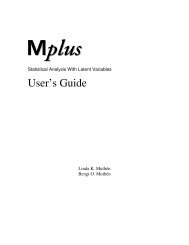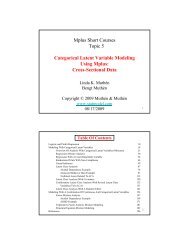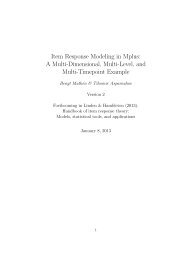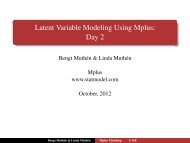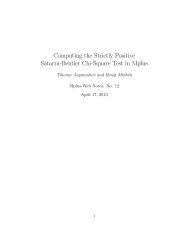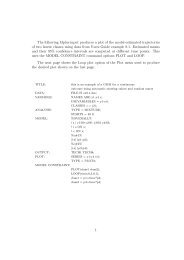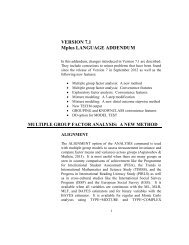Incorporating Latent Variables into Discrete Choice Models - A - Mplus
Incorporating Latent Variables into Discrete Choice Models - A - Mplus
Incorporating Latent Variables into Discrete Choice Models - A - Mplus
Create successful ePaper yourself
Turn your PDF publications into a flip-book with our unique Google optimized e-Paper software.
<strong>Incorporating</strong> <strong>Latent</strong> <strong>Variables</strong> <strong>into</strong> <strong>Discrete</strong> <strong>Choice</strong> <strong>Models</strong> -<br />
A Simultaneous Estimation Approach Using SEM Software<br />
Dirk Temme, Marcel Paulssen, Till Dannewald<br />
Accounting | Finance | Management | Marketing | Operations and Information Systems<br />
Volume 1 | Issue 2 | December 2008 | www.business-research.org | ISSN 1866-8658
BuR - Business Research<br />
Official Open Access Journal of VHB<br />
Verband der Hochschullehrer für Betriebswirtschaft e.V.<br />
Volume 1| Issue 2 | December 2008 | 220-237<br />
<strong>Incorporating</strong> <strong>Latent</strong> <strong>Variables</strong> <strong>into</strong> <strong>Discrete</strong><br />
<strong>Choice</strong> <strong>Models</strong> – A Simultaneous Estimation<br />
Approach Using SEM Software<br />
Dirk Temme, Institute of Marketing, Humboldt University of Berlin, Germany, E-Mail: temme@wiwi.hu-berlin.de<br />
Marcel Paulssen, HEC Hautes Etudes Commerciales, Université de Genève, Switzerland, E-Mail: Marcel.Paulssen@unige.ch<br />
Till Dannewald, Infas TTR Frankfurt, Germany, E-Mail: till.dannewald@infas-ttr.de<br />
Abstract<br />
Integrated choice and latent variable (ICLV) models represent a promising new class of models which<br />
merge classic choice models with the structural equation approach (SEM) for latent variables. Despite<br />
their conceptual appeal, applications of ICLV models in marketing remain rare. We extend previous ICLV<br />
applications by first estimating a multinomial choice model and, second, by estimating hierarchical relations<br />
between latent variables. An empirical study on travel mode choice clearly demonstrates the value of<br />
ICLV models to enhance the understanding of choice processes. In addition to the usually studied directly<br />
observable variables such as travel time, we show how abstract motivations such as power and hedonism<br />
as well as attitudes such as a desire for flexibility impact on travel mode choice. Furthermore, we show that<br />
it is possible to estimate such a complex ICLV model with the widely available structural equation modeling<br />
package <strong>Mplus</strong>. This finding is likely to encourage more widespread application of this appealing<br />
model class in the marketing field.<br />
Keywords: Hybrid choice models, Mode choice, <strong>Mplus</strong>, Value-attitude hierarchy<br />
Manuscript received June 13, 2008, accepted by Adamantios Diamantopoulos (Marketing) November 11,<br />
2008.<br />
1. Introduction<br />
<strong>Discrete</strong> choice models are extensively used in various<br />
academic fields to analyze a huge range of<br />
choices between mutually exclusive alternatives<br />
(e.g., brands, service providers, travel modes, financial<br />
investments, residences, political parties, or<br />
strategies). Traditionally, these models have directly<br />
mapped observed features of alternatives and observed<br />
characteristics of decision makers to overt<br />
choice behavior. For instance, in order to explain<br />
travel mode choice for daily work trips, modal attributes<br />
(e.g., travel time and cost) as well as commuter<br />
socio-demographics (e.g., household income<br />
and number of drivers in a household) have been<br />
considered (e.g., Train 1978). The decision maker’s<br />
internal processes during preference formation and<br />
notably the role of factors that are not directly ob-<br />
220<br />
servable, such as attitudes or lifestyle preferences,<br />
remain unexplained in a so-called “black box” in<br />
traditional discrete choice analysis.<br />
Meanwhile, researchers have increasingly recognized<br />
that decision makers differ significantly in<br />
psychological constructs such as attitudes, perceptions,<br />
values, or lifestyle preferences and that these<br />
factors affect an alternative’s utility in a systematic<br />
way (Ben-Akiva, McFadden, Train, Walker, Bhat,<br />
Bierlaire, Bolduc, Boersch-Supan, Brownstone,<br />
Bunch, Daly, De Palma, Gopinath, Karlstrom, and<br />
Munizaga 2002; Walker and Ben-Akiva 2002).<br />
Mode choice decisions, for example, might not only<br />
depend on objective criteria (e.g., time, income) but<br />
also on commuters’ preferences for convenience,<br />
safety, or flexibility (e.g., Vredin Johansson, Heldt,<br />
and Johansson 2006). Two otherwise identical<br />
commuters differing in their desire for flexibility
BuR - Business Research<br />
Official Open Access Journal of VHB<br />
Verband der Hochschullehrer für Betriebswirtschaft e.V.<br />
Volume 1| Issue 2 | December 2008 | 220-237<br />
might thus choose different travel modes. Extending<br />
choice models with latent variables representing<br />
attitudes or values can therefore lead to a deeper<br />
understanding of the choice processes taking place<br />
in the consumer’s “black box” and at the same time<br />
should provide greater explanatory power. Therefore,<br />
integrated choice and latent variable (ICLV)<br />
models which merge classic choice analysis with the<br />
structural equation approach (SEM) for latent variables<br />
represent a promising new class of models.<br />
Recently, some encouraging applications of ICLV<br />
models have appeared in the literature: Explaining<br />
prototype choice in conjoint analysis by incorporating<br />
subjective product characteristics (i.e., perceptions)<br />
(Luo, Kannan, and Ratchford 2008); analyzing<br />
private asset investments taking <strong>into</strong> account<br />
factors such as individual risk attitude and impatience<br />
(Eyman, Börsch-Supan, and Euwals 2002);<br />
and modeling the impact of lifestyle preferences on<br />
residence choice (Walker and Li 2007).<br />
Despite their conceptual appeal, there are still relatively<br />
few applications of ICLV models in marketing<br />
and related fields. The major reason for their lack of<br />
popularity is most likely the fact that full information<br />
estimation of these models is rather involved<br />
and hitherto it was been required that researchers<br />
develop their own programs (Ben-Akiva, McFadden,<br />
Train, Walker, Bhat, Bierlaire, Bolduc, Börsch-<br />
Supan, Brownstone, Bunch, Daly, De Palma, Gopinath,<br />
Karlstrom, and Munizaga 2002). 1 Most of the<br />
rare current applications are restricted to binary<br />
choice and, with the noticeable exception of the<br />
paper by Dellaert and Stremersch (2005), only consider<br />
direct effects of latent variables on choice (e.g.,<br />
Ben-Akiva, Walker, Bernardino, Gopinath, Morikawa,<br />
and Polydoropoulou 2002; Ashok, Dillon,<br />
and Yuan 2002). Thus, causal relationships between<br />
latent variables commonly investigated in structural<br />
equation modeling are neglected. In contrast, we<br />
test a behavioral theory, the value-attitude hierarchy,<br />
which proposes hierarchical relationships between<br />
latent variables in a discrete choice analysis.<br />
Furthermore, by applying the program <strong>Mplus</strong><br />
(Muthén and Muthén 1998–2007), one of the most<br />
comprehensive software packages for SEM, we present<br />
a powerful and very flexible option for estimat-<br />
1 Vredin Johansson, Heldt, and Johansson (2006), for instance,<br />
avoided the simultaneous estimation approach because<br />
it was considered rather cumbersome.<br />
221<br />
ing ICLV models which has not been considered so<br />
far.<br />
To sum up, our paper primarily provides a methodical<br />
contribution. We extend previous ICLV applications<br />
by first estimating a multinomial choice model<br />
and, second, by estimating hierarchical relations<br />
between latent variables. Thus, unlike previous<br />
applications of the ICLV model, we do not only include<br />
latent variables as an additional set of predictors<br />
(e.g., Ben-Akiva, Walker, Bernardino, Gopinath,<br />
Morikawa, and Polydoropoulou 2002;<br />
Ashok, Dillon, and Yuan 2002). Furthermore, our<br />
paper extends the transportation choice literature<br />
by testing a value-attitude hierarchy with the impact<br />
of commuters’ personal values on “soft” choice criteria<br />
and on subsequent mode choice.<br />
The remaining part of the paper is structured as<br />
follows: First, we introduce the general structure of<br />
ICLV models and discuss their estimation with the<br />
<strong>Mplus</strong> software. Then, we illustrate the applicability<br />
of <strong>Mplus</strong> in an empirical study on travel mode<br />
choice. A hierarchical behavioral model is tested in<br />
which we include values and attitudes as well as<br />
traditional alternative-specific and sociodemographic<br />
variables such as explanatory variables.<br />
Next, we discuss the implications of the comprehensive<br />
ICLV framework in general as well as in<br />
the context of our empirical study. We conclude by<br />
addressing some limitations and by providing avenues<br />
for further research.<br />
2. The integrated choice and latent<br />
variable model<br />
In the general formulation of the ICLV model, two<br />
components can be distinguished: a multinomial<br />
discrete choice model and a latent variable model<br />
(see Figure 1). Each of these submodels consists of a<br />
structural and a measurement part. In the discrete<br />
choice part, the alternatives’ utilities may depend on<br />
both observed and latent characteristics of the options<br />
and decision makers. Utility as a theoretical<br />
construct is operationalized by a single nominal<br />
indicator representing the observed choice for each<br />
individual. The latent variable part is rather flexible<br />
in that it allows for both simultaneous relationships<br />
between the latent variables and MIMIC-type models<br />
(Jöreskog and Goldberger 1975) where observed<br />
exogenous variables influence the latent variables.<br />
Such a specification enables the researcher to disentangle<br />
the direct and indirect effects of observed as
BuR - Business Research<br />
Official Open Access Journal of VHB<br />
Verband der Hochschullehrer für Betriebswirtschaft e.V.<br />
Volume 1| Issue 2 | December 2008 | 220-237<br />
well as latent variables on the alternatives’ utilities.<br />
The latent variables themselves are assumed to be<br />
measured by multiple indicators representing, for<br />
example, the respondents’ answers to survey items.<br />
2.1 Model specification<br />
The structure and full information estimation of the<br />
ICLV model will now be discussed in more detail.<br />
For alternative treatments refer, for example, to<br />
Ashok, Dillon, and Yuan (2002), Walker and Ben-<br />
Akiva (2002), and Bolduc, Ben-Akiva, Walker and<br />
Michaud (2005).<br />
Figure 1: Framework for integrated choice<br />
and latent variable models<br />
Observed<br />
exogenous<br />
variable(s)<br />
x<br />
<strong>Latent</strong><br />
variable<br />
η η 2<br />
• • •<br />
Utility<br />
U<br />
Observed<br />
choice<br />
d<br />
<strong>Discrete</strong> choice model<br />
<strong>Discrete</strong> <strong>Choice</strong> Model: The random utility component<br />
is based on the assumption that a decision<br />
maker n (n = 1,…, N), faced with a finite set C of n<br />
mutually exclusive alternatives i (i = 1,…, I ), n<br />
chooses the option i which provides the greatest<br />
utility U . Each alternative’s utility is described as a<br />
ni<br />
function of explanatory variables forming the systematic<br />
part of the utility, V(·), and disturbances, ν ni ,<br />
representing the stochastic utility component:<br />
(1) ( x η β )<br />
<strong>Latent</strong><br />
variable<br />
η η Μ Μ<br />
U = V , ; + ν ,<br />
ni ni ni ni<br />
<strong>Latent</strong><br />
variable<br />
η η 1<br />
where x ni is a (K × 1) vector of observed variables<br />
and η ni is a (M × 1) vector of latent variables. These<br />
Indicator<br />
y 1<br />
Indicator<br />
y 2<br />
•<br />
•<br />
•<br />
Indicator<br />
y<br />
p 1<br />
222<br />
variables represent either (latent) characteristics of<br />
the decision maker (x , η ) or (latent) attributes of<br />
sn sn<br />
the alternatives (x , η ). The importance of the<br />
zni zni<br />
explanatory variables on the utility of the options is<br />
reflected in the ((K+M) × 1) vector β. By assuming,<br />
for example, that each ν is independently, identi-<br />
ni<br />
cally distributed (i.i.d.) extreme value, the widely<br />
used multinomial logit (MNL) model results<br />
(e.g., Ben-Akiva and Lerman 1985):<br />
V ( xni<br />
, η ni ; β )<br />
e<br />
(2) P ( uni<br />
= 1|<br />
xni,<br />
ηni;<br />
β ) = V ( xnj<br />
, η nj ; β )<br />
∑e j∈C<br />
n<br />
As is common practice in choice modeling, the representative<br />
utility V(⋅) is specified<br />
to be linear in parameters:<br />
<strong>Latent</strong><br />
variable<br />
model<br />
structural relationships in<br />
the discrete choice model<br />
structural relationships in<br />
the latent variable model<br />
measurement relationships<br />
(adapted from Ben -Akiva et al. 1999, p.195 )<br />
(3)<br />
' '<br />
= β x + βη ,<br />
Vni x ni η ni<br />
where β x and β η is a (K × 1) and a<br />
(M × 1) vector, respectively.<br />
<strong>Latent</strong> Variable Model: Model<br />
identification typically requires<br />
that the unobserved ηs are operationalized<br />
by multiple manifest<br />
variables, y. 2 In the simplest case,<br />
a linear factor model is appropriate<br />
for describing the mapping of<br />
the indicators onto the latent variables,<br />
leading to the following<br />
measurement equation:<br />
(4)<br />
y = Λη + ε<br />
ni ni ni<br />
where y ni is a (P × 1) vector, Λ is a (P × M) matrix of<br />
factor loadings, and ε ni is a (P × 1) vector of meas-<br />
urement errors which are i.i.d. multivariate normal.<br />
3 Our structural model for the latent variables<br />
integrates alternative formulations by Ashok, Dillon,<br />
and Yuan (2002) and Walker and Ben-Akiva (2002)<br />
by allowing for interrelationships among the latent<br />
variables as well as for the influence of observed<br />
2 This has been established in further analyses.<br />
3 Alternatively, for ordinal indicators, a factor model with<br />
continuous latent response variables might be specified<br />
(Muthén 1983, 1984).<br />
,
BuR - Business Research<br />
Official Open Access Journal of VHB<br />
Verband der Hochschullehrer für Betriebswirtschaft e.V.<br />
Volume 1| Issue 2 | December 2008 | 220-237<br />
explanatory variables xni on the latent variables: 4<br />
(5)<br />
η = Βη + Γx+<br />
ζ ,<br />
ni ni ni ni<br />
where the (M × M) matrix B and the (M × L) matrix<br />
Γ contain unknown regression coefficients. The<br />
(M × 1) vector ζ ni represents random disturbances<br />
assumed to be i.i.d. multivariate normal.<br />
Likelihood Function: Since all information about<br />
the latent variables is contained in the multiple observed<br />
indicators, the joint probability of the choice<br />
and latent variable indicators conditioned on the<br />
exogenous variables is considered. Assuming that<br />
the random errors ν, ε, and ζ are independent, integrating<br />
over the joint distribution of the latent variables<br />
leads to the following multidimensional integral:<br />
5<br />
(6)<br />
P(<br />
ui<br />
= 1|<br />
x,<br />
θ ) = ∫ Pu<br />
( ui<br />
= 1|<br />
x,<br />
η,<br />
β,<br />
Σv<br />
)<br />
ε<br />
Rη<br />
× f ( y | η,<br />
Λ,<br />
Σ ) f ( η | x;<br />
B,<br />
Γ,<br />
Σ ) dη<br />
y<br />
η<br />
where θ represents the model parameters, Pu denotes<br />
the probability function of observing the<br />
choice of a specific alternative (2), the density function<br />
fy for the latent variable indicators relates to the<br />
measurement model (4), and the density function f η<br />
of the latent variables corresponds to the structural<br />
model (5). Σv, Σε, and Σζ indicate covariance matrices<br />
for the residuals. R η denotes that integration is<br />
over the range space of the vector of latent variables<br />
that have a direct impact on the choice decision.<br />
If maximum likelihood techniques are applied to<br />
estimate the parameter vector θ in (6), for any particular<br />
individual we obtain the following likelihood<br />
function:<br />
(7)<br />
L =<br />
=<br />
R i∈C<br />
η n<br />
× f ( η | x;<br />
B,<br />
Γ,<br />
Σ ) dη<br />
η<br />
∏<br />
i∈Cn<br />
∫∏<br />
ui<br />
P(<br />
u = 1,<br />
y | x,<br />
θ )<br />
P(<br />
u = 1|<br />
x,<br />
η,<br />
β,<br />
Σ )<br />
i<br />
i<br />
ζ<br />
ui<br />
v<br />
ζ<br />
f ( y | η,<br />
Λ,<br />
Σ )<br />
4 For simplicity, it is assumed that the same set of observed<br />
exogenous variables x as in the random utility equation (1)<br />
enters the structural model for the latent variables. Of course,<br />
different variable sets can be defined for both equations.<br />
5 The index denoting the individual decision maker has been<br />
dropped for notational simplicity.<br />
y<br />
ε<br />
223<br />
where u = 1 if the decision maker chooses i and zero<br />
i<br />
otherwise.<br />
2.2 Estimation<br />
The simplest way to include psychological constructs<br />
in a discrete choice analysis is to perform a<br />
sequential estimation (e.g., Ashok, Dillon, and Yuan<br />
2002). First, the latent variable part of the ICLV<br />
model is estimated (Eqs. (4) and (5)) and factor<br />
scores are computed. Second, factor scores substitute<br />
the latent variables in the discrete choice model<br />
(Eq. (3)) as additional error-free exogenous variables<br />
x ni. This two-step limited information estimation<br />
is straightforward, using standard software for<br />
both discrete choice (e.g., SAS, NLOGIT, or STATA)<br />
and SEM (e.g., LISREL, AMOS, or EQS) analysis.<br />
However, the approach is deficient in the sense that<br />
(1) it leads to inconsistent and biased estimates for<br />
the random utility part (e.g., Walker and Ben-Akiva<br />
2002) 6 and (2) does not allow to test behavioral<br />
theories including more complex relationships between<br />
latent predictors and revealed choice (e.g.,<br />
direct and indirect effects for multiple layers of latent<br />
variables).<br />
Full information estimation, on the other hand, is<br />
rather involved due to the multidimensional integral<br />
in Eq. (6). For a restricted number of latent variables<br />
(typically three or fewer variables) entering the<br />
utility function, numerical integration methods like<br />
Gaussian quadrature are feasible (e.g., Ashok, Dillon,<br />
and Yuan 2002). With an increasing number of<br />
latent variables, the computational complexity rises<br />
exponentially. Hence, in the case of more than three<br />
latent variables, other techniques like Monte Carlo<br />
integration are found to be more appropriate (for a<br />
discussion see Judd (1998)). So far, researchers<br />
conducting full information estimation of an ICLV<br />
model have developed their own routines in flexible<br />
statistic software such as GAUSS (e.g., Ashok, Dillon,<br />
and Yuan 2002). A more convenient way proposed<br />
here is to use the SEM software package<br />
<strong>Mplus</strong> (Muthén and Muthén 1998-2007) the capabilities<br />
of which make it suitable for a broad range of<br />
applications of the ICLV approach. 7 Besides offering<br />
6 For a sequential estimation approach, which leads to consistent<br />
but not fully efficient estimators, see Morikawa, Ben-<br />
Akiva, and McFadden (2002).<br />
7 Alternatively, ICLV models might be estimated using the<br />
software programs GLAMM (Skrondal and Rabe-Hesketh<br />
2004) or <strong>Latent</strong> GOLD <strong>Choice</strong> (Vermunt and Magidson 2005).
BuR - Business Research<br />
Official Open Access Journal of VHB<br />
Verband der Hochschullehrer für Betriebswirtschaft e.V.<br />
Volume 1| Issue 2 | December 2008 | 220-237<br />
the full flexibility of an SEM program to specify<br />
complex structures of latent variables, both numerical<br />
and Monte Carlo integration are available for<br />
simultaneously estimating a multinomial logit<br />
model with latent predictors. <strong>Mplus</strong> allows one to<br />
perform both conventional as well as robust maximum<br />
likelihood estimation. In the latter case, the<br />
asymptotic standard errors are corrected for nonsevere<br />
violations of the distributional assumptions<br />
associated with the stochastic disturbances. We will<br />
now briefly outline the peculiarities of the <strong>Mplus</strong><br />
approach for the analysis of ICLV models.<br />
Whereas SEM in its narrowest formulation assumes<br />
continuous indicators, <strong>Mplus</strong> allows for a proper<br />
treatment of various other types of observed data<br />
(e.g., ordered and unordered categorical). In the<br />
present case, we make use of <strong>Mplus</strong>’ ability to handle<br />
nominal indicators representing the observed<br />
choice for each decision maker. Even though specifying<br />
an unconditional MNL model in <strong>Mplus</strong> is<br />
straightforward, estimating a conditional MNL<br />
model including alternative-specific variables is<br />
slightly more difficult. 8 The reason for this is that for<br />
the last alternative no explicit utility function can be<br />
specified. Since only differences in utility matter<br />
(e.g., Train 2003), this issue can be solved by expressing<br />
the utilities of the other choice options as<br />
differences with respect to the last alternative’s utility.<br />
For that purpose, the model constraint option<br />
implemented in <strong>Mplus</strong> is used. To be more specific,<br />
an alternative-specific variable describing the last<br />
choice option enters all other utility functions with<br />
the opposite sign by specifying the required linear<br />
constraint for the parameter of that variable. Because<br />
the effect of individual-specific variables is not<br />
identified for all alternatives, for each such variable<br />
one parameter has to be normalized to zero; 9 the<br />
same also applies to the alternative-specific constants<br />
which capture the average influence of unobserved<br />
effects on an alternative’s utility. In <strong>Mplus</strong>,<br />
these constraints are imposed by default, as all parameters<br />
in the utility function of the last choice<br />
option are fixed to zero.<br />
Since <strong>Mplus</strong>’ model specification underlying the<br />
analysis of nominal variables is not well documented,<br />
we assessed the validity of our approach in<br />
8 For a discussion of both the unconditional and the conditional<br />
logit model see, for example, Green (2008).<br />
9 For alternative identification constraints refer to Train<br />
(2003).<br />
224<br />
two ways: First, estimation results for a conventional<br />
conditional MNL model were compared to<br />
those of standard software (NLOGIT and STATA);<br />
no differences to the <strong>Mplus</strong> parameter estimates<br />
were revealed. Second, a Monte Carlo simulation<br />
study including four observed and two latent explanatory<br />
variables was conducted using both numerical<br />
and Monte Carlo integration. The performance<br />
of <strong>Mplus</strong> has been assessed in terms of the<br />
mean absolute relative bias (MARB) of both the<br />
parameter estimates and the standard errors, and<br />
the 95% coverage rate. The simulation results provide<br />
the confidence to conclude that <strong>Mplus</strong> performs<br />
reasonably well at sample sizes of 500 (under<br />
this condition the MARB for the coefficient estimates<br />
only slightly exceeds the threshold value of<br />
0.025 suggested by Boomsma and Hoogland 2001).<br />
Excellent results emerge for a sample size of n =<br />
1,000. 10 In the following chapter, we apply <strong>Mplus</strong> to<br />
estimate an ICLV model with hierarchical relations<br />
between latent variables to explain travel mode<br />
choice.<br />
3. Empirical analysis of an<br />
integrated choice and latent variable<br />
model of (travel mode) choice<br />
3.1 Model development<br />
In traditional travel choice models, individual mode<br />
choice is analyzed both as a function of individual<br />
characteristics of the decider such as income, employment<br />
status, gender, number of children, etc.,<br />
and of attributes of the travel mode alternatives<br />
such as travel time, travel cost, availability, etc.<br />
However, in the last 10 years, many researchers<br />
have criticized this approach and called for the inclusion<br />
of unobservable or latent variables such as<br />
preferences for convenience, flexibility, or safety<br />
<strong>into</strong> models of mode choice (e.g., McFadden 1986;<br />
Ashok, Dillon, and Yuan 2002; Morikawa, Ben-<br />
Akiva, and McFadden 2002). The overall idea is that<br />
the inclusion of latent variables, mirroring an individual’s<br />
preference or attitudes, is a more adequate<br />
representation of behavior and helps to gain valuable<br />
insight <strong>into</strong> the decision-making process of the<br />
individual (Vredin Johansson, Heldt, and Johansson<br />
2006). In the following, we develop an extended<br />
10 More detailed results of the Monte Carlo study can be requested<br />
from the first author.
BuR - Business Research<br />
Official Open Access Journal of VHB<br />
Verband der Hochschullehrer für Betriebswirtschaft e.V.<br />
Volume 1| Issue 2 | December 2008 | 220-237<br />
choice model of travel mode choice based on an<br />
individual’s values, attitudes, and demographics as<br />
well as typical characteristics of the traffic mode<br />
alternatives such as time and availability. Recent<br />
research indicates that more abstract constructs<br />
such as values, lifestyle orientation, and personality<br />
traits might also impact travel mode choice (Choo<br />
and Mokhtarian 2004; Nordlund and Garwill 2003;<br />
Collins and Chambers 2005). Especially values 11<br />
have received some attention, and several researchers<br />
have investigated their role in travel mode<br />
choice (Bamberg 1996; Bamberg and Kühnel 1998;<br />
Choo and Mokhtarian 2004; Lanzendorf 2002).<br />
None of those studies have, however, developed and<br />
tested a model on how values impact actual transport<br />
mode choice. Since results for direct valuebehavior<br />
relationships are often disappointing (e.g.,<br />
Kassarjian and Sheffet 1991; Kristiansen and Hotte<br />
1996), researchers have proposed that values impact<br />
specific behaviors through intervening constructs.<br />
Empirical validations of a mediated impact on behavior<br />
(intentions, preferences) through the socalled<br />
value-attitude hierarchy have been conducted<br />
by, among others, McCarthy and Shrum (1994) and<br />
Thøgersen and Grunert-Beckmann (1997). Building<br />
on this research, we propose that values affect the<br />
classic attitudes towards mode choice, such as preferences<br />
for comfort/convenience, flexibility, and<br />
safety:<br />
P1: Respondents’ value orientations affect their attitudes<br />
towards mode choice.<br />
As stated above, recent research has shown that the<br />
inclusion of attitudes in models of transport mode<br />
choice leads to substantial improvements in terms<br />
of model fit as well as explanation and further provides<br />
a more satisfying representation of behavior<br />
(Choo and Moktarian 2004; Ben-Akiva, Walker,<br />
Bernardino, Gopinath, Morikawa, and Polydoropoulou<br />
2002; Vredin Johansson, Heldt, and Johansson<br />
2006). We build on recent research by<br />
Vredin Johansson, Heldt, and Johansson (2006)<br />
and include attitudes towards mode choice such as<br />
convenience and flexibility in our model. Following<br />
the results of the cited studies, these attitudes are<br />
proposed to influence mode choice:<br />
11 See, e.g., Schwartz and Bilsky 1990; Bardi and Schwartz<br />
2003 for a definition of the value construct and a discussion<br />
regarding its impact on behavior.<br />
225<br />
P2: Attitudes towards mode choice affect mode<br />
choice.<br />
What are the sources of value orientation? People’s<br />
demographic characteristics such as age, gender,<br />
and income largely determine people’s life circumstances<br />
in terms of their socialization, their social<br />
roles, their life stage, and their expectations. Differences<br />
in life circumstances in turn affect the salience<br />
of values (Schwartz 2003). Examples for age and<br />
gender might illustrate this point. With increasing<br />
age, the ability to cope with change is waning and<br />
security values become more relevant. Socialization<br />
leads boys and girls to adopt different social roles<br />
with different life goals and orientations. Women,<br />
being more relational and communal than men,<br />
tend to attribute more importance to benevolence<br />
values and less importance to power values (Prince-<br />
Gibson and Schwartz 1998; Schwartz and Rubel<br />
2005). We accordingly propose:<br />
P3: Socio-demographic characteristics (age, income,<br />
gender) affect values.<br />
In their behavioral framework for choice models<br />
with latent variables, Ben-Akiva, Walker, Bernardino,<br />
Gopinath, Morikawa, and Polydoropoulou<br />
(2002) proposed that socio-demographic characteristics<br />
of an individual affect his/her attitudes<br />
(e.g., the relevance of flexibility of a transport mode<br />
depends on having children or not). Vredin Johansson,<br />
Heldt, and Johansson (2006) tested that<br />
proposition and demonstrated that demographic<br />
variables impacted attitudes of flexibility and comfort.<br />
We accept these results and propose:<br />
P4: Socio-demographic characteristics affect attitudes<br />
towards mode choice.<br />
Most empirical models on travel mode choice use<br />
modal attributes such as travel time and cost, as<br />
well as individual socio-demographic characteristics<br />
such as age and education as explanatory variables<br />
for mode choice behavior (e.g., Vredin Johansson,<br />
Heldt, and Johansson 2006). We expect similar<br />
effects in our study and propose:<br />
P5: Socio-demographic characteristics (e.g., age,<br />
income, gender) affect mode choice.<br />
P6: Traffic mode attributes (e.g., travel time) affect<br />
mode choice.<br />
In summary, our application specifically investigates<br />
the influence of psychological factors (individ-
BuR - Business Research<br />
Official Open Access Journal of VHB<br />
Verband der Hochschullehrer für Betriebswirtschaft e.V.<br />
Volume 1| Issue 2 | December 2008 | 220-237<br />
ual values, attitudes) in concert with known observed<br />
variables (access, time, age, gender) on<br />
commuter mode choice (see Figure 2). Six propositions<br />
were derived from the literature review and<br />
will now be tested in an empirical analysis of commuter<br />
mode choice.<br />
Figure 2: Structure of the integrated choice<br />
and hierarchical latent variable model on<br />
mode choice.<br />
alternativespecific<br />
attributes<br />
Travel time<br />
car<br />
Travel time<br />
public transport<br />
Distance to bus<br />
Distance to other<br />
public transport<br />
P 6<br />
Socio-demographic<br />
variables<br />
P 5<br />
Mode<br />
utility<br />
Observed<br />
choice<br />
P 3<br />
P 4<br />
3.2 Data and methods<br />
Data for our analysis of travel mode choice came<br />
from a sample of German consumers between 14<br />
and 75 years of age. Following a survey pre-test with<br />
20 subjects, 907 respondents were drawn from a<br />
consumer panel of a major international market<br />
research company. The survey was administered in<br />
a computer-aided telephone interview. Panelists<br />
were recruited following a demographic quota sampling<br />
approach based on age, profession as a proxy<br />
for status, gender, household size, and size of<br />
city/place of residence. The sample distribution on<br />
demographic variables did not significantly deviate<br />
from the population distribution. The overall survey<br />
response rate of the invited panellists was 45%.<br />
The questionnaire consisted of five major parts: In<br />
the first section, respondents were asked demographic<br />
questions needed for quota sampling. The<br />
second section included questions about personal<br />
mobility. Respondents were asked about the possession<br />
of a driver’s license, of seasonal tickets for public<br />
transport alternatives (bus, streetcar, integrated<br />
public transport system, railroad), and about possession<br />
of cars. Furthermore, the distance to the<br />
226<br />
nearest stations of various public transport alternatives<br />
(if available) and the time needed for daily<br />
trips to work with public transport as well as by car<br />
had to be estimated. In the third section, we asked<br />
about attitudes towards transport modes for daily<br />
trips to work. This section was modeled after a recent<br />
paper by Vredin Johansson, Heldt, and Johansson<br />
(2006) and a previously published working<br />
paper (Vredin Johansson, Heldt, and Johansson<br />
2005), where respondents had to rate attitudinal<br />
questions relating to modal<br />
comfort, convenience, and<br />
Indicators<br />
flexibility on five-point scales<br />
ranging from not important<br />
P 1<br />
at all to very important. In<br />
the fourth section, we asked<br />
Indicators<br />
respondents about their<br />
mode choice for daily trips to<br />
work or education. Respondents<br />
had to indicate<br />
whether they predominantly<br />
used car, public transport, or<br />
a combination of both. The<br />
survey closed with a section<br />
where we measured respondents’<br />
value orientations<br />
with the Portraits Value Questionnaire (PVQ) from<br />
Schwartz, Melech, Lehmann, Burgess, Harris, and<br />
Owens (2001). Respondents had to indicate their<br />
similarity to person descriptions (portraits); gendermatched<br />
with the respondent on six-point rating<br />
scales ranging from very unlike to very much alike<br />
(Schwartz, Melech, Lehmann, Burgess, Harris, and<br />
Owens 2001).<br />
Values<br />
Attitudes<br />
P 2<br />
P P1, 1, P P2, 2, ... P P6: 6: Propositions guiding the study<br />
Table 1: Descriptive statistics stratified by<br />
travel mode choice<br />
Gender<br />
(females = 1)<br />
Public<br />
transport<br />
n = 50<br />
Car +<br />
Public<br />
transport,<br />
n = 57<br />
Car only,<br />
n = 412<br />
M SD M SD M SD<br />
0.52 0.51 0.40 0.50 0.50 0.50<br />
Age (years) 39.50 13.81 40.32 14.71 40.12 13.04<br />
Income<br />
(in Euro)<br />
2,242 979 2,395 1,205 2,640 1,352<br />
Notes: n = number of observations for each travel mode,<br />
M = mean, SD = standard deviation
BuR - Business Research<br />
Official Open Access Journal of VHB<br />
Verband der Hochschullehrer für Betriebswirtschaft e.V.<br />
Volume 1| Issue 2 | December 2008 | 220-237<br />
For 43% of the respondents in our sample, daily<br />
trips to work/education were not applicable (e.g.,<br />
they were housewives/househusbands, unemployed<br />
or retired) or alternative travel modes did not exist<br />
(e.g., they did not possess a driver’s license or had<br />
no car in the household). After deletion of these<br />
cases (see Vredin Johansson, Heldt, and Johansson<br />
(2006) for a similar approach), our analytic sample<br />
thus consisted of N = 519 respondents (for descriptive<br />
statistics see Table 1).<br />
3.3 Results<br />
3.3.1 Confirmatory factor analysis<br />
We followed the two-step approach in structural<br />
equation modeling (e.g., Anderson and Gerbing<br />
1988) and first tested the reliability and validity of<br />
the measurement models used in the study by<br />
means of confirmatory factor analysis. Item formulations<br />
for both the attitude and value constructs are<br />
reported in Appendix A1. As stated in the previous<br />
section, building on Vredin Johansson, Heldt, and<br />
Johansson (2006) we developed items for the three<br />
dimensions flexibility, convenience/comfort, and<br />
safety. Unfortunately, the measurement model for<br />
safety did not work as expected. The reason for this<br />
result may be that the three original items were a<br />
mixture of personal safety and traffic safety attitudes<br />
in mode choice. Since also Vredin Johansson,<br />
Heldt, and Johansson (2006) reported that the<br />
differences of different modes with respect to traffic<br />
safety are negligible, we decided to keep the possession<br />
item (see Appendix A1) as an admittedly<br />
suboptimal measure of attitude towards personal<br />
safety in mode choice. In<br />
prior qualitative interviews,<br />
some of the respondents<br />
mentioned that in public<br />
transport they felt threatened<br />
or uneasy due to the<br />
presence of unwanted others.<br />
In contrast, for cars,<br />
possession allowed them to<br />
be on their own or to select<br />
the persons they travel with.<br />
Reliability for this single<br />
item has been fixed to a value of .80. Although<br />
Schwartz’s Portraits Questionnaire provides wellestablished<br />
and validated scales, results of separate<br />
confirmatory factor analyses for the focal value con-<br />
227<br />
structs prompted us to eliminate two further items:<br />
one for power and one for security (see Appendix<br />
A1).<br />
Our final confirmatory factor model for attitudes<br />
towards mode choice and values has been estimated<br />
with the robust WLSMV estimator implemented in<br />
the <strong>Mplus</strong> software (Muthén and Muthén 1998–<br />
2007, Version 5.1). Goodness-of-fit statistics for this<br />
model indicate an acceptable overall fit to the data<br />
(χ 2 =131.28, df=57, NNFI=.91, CFI=.90,<br />
RMSEA=.05, weighted RMSR=.90). 12 Convergent<br />
validity is established by statistically significant<br />
factor loadings with t-statistics ranging from 5.07 to<br />
10.14. Completely standardized factor loadings<br />
range from .47 to .70 for the attitude and from .50 to<br />
.79 for the value measures. Except for the factor<br />
convenience/comfort, all construct reliabilities (see<br />
Table 2) are above a recommended threshold of .60<br />
(Bagozzi and Yi 1988).<br />
Since the squared correlation between the two attitude<br />
constructs flexibility and convenience/comfort<br />
is larger than the average variance extracted for<br />
both factors (thus indicating a possible violation of<br />
discriminant validity (Fornell and Larcker 1981); see<br />
Table 2), we estimated a modified factor model<br />
where (1) the correlation between both factors has<br />
been fixed to unity and (2) the correlations of both<br />
constructs with like factors have been constrained to<br />
be equal (van der Sluis, Dolan, and Stoel 2005).<br />
The highly significant chi-square difference<br />
(Δχ 2 =54.31, df=5, p=.000) provides support for the<br />
discriminant validity of both constructs.<br />
Table 2: Construct reliability and validity measures<br />
Construct 1 2 3 4 5 6<br />
1. Flexibility .67, .41<br />
2. Conv./Comf. .45 .53, .27<br />
3. Safety .13 .09 .80, .80a 4. Power .06 .07 .01 .78, .58<br />
5. Hedonism .02 .13 .02 .03 .70, .44<br />
6. Security .05 .31 .08 .03 .03 .62, .42<br />
Notes: Entries on the diagonal represent (1) Bagozzi’s (1980) construct reliability ρc and (2) Fornell<br />
and Larcker’s (1981) average variance extracted ρave.<br />
The off-diagonal elements are squared correlations among the constructs.<br />
All intercorrelations are significant at p
BuR - Business Research<br />
Official Open Access Journal of VHB<br />
Verband der Hochschullehrer für Betriebswirtschaft e.V.<br />
Volume 1| Issue 2 | December 2008 | 220-237<br />
3.3.2 Classic MNL and ICLV analysis<br />
In order to test our ICLV model of travel mode<br />
choice and to assess to what extent the latent valueattitude<br />
hierarchy provides additional explanatory<br />
power, we first estimated a classic MNL model. This<br />
model only contains directly observed variables<br />
describing the choice alternatives (e.g., travel time)<br />
and the decision makers (e.g., age). The utilities of<br />
the three mode choice alternatives (public transport<br />
only (PTO), car + public transport (CPT), and car<br />
only (CO)) are given by: 13<br />
(8)<br />
U PTO = V ( xPTO,<br />
β x ) + v<br />
PTO PTO<br />
= β0,<br />
PTO + β1TTPT<br />
, PTO + β3DB<br />
+ β5DOPT<br />
+ β AGE + β GEND + β INC + v<br />
U<br />
CO<br />
7<br />
= V ( x<br />
CO<br />
CPT<br />
xCO<br />
) + v<br />
CO<br />
= β TT<br />
PTO<br />
UCPT<br />
= V ( xCPT<br />
, β x ) + v<br />
CPT CPT<br />
= β 0,<br />
CPT+<br />
β1TTPT<br />
, CPT + β2TTC<br />
, CPT + β4DB<br />
+ β6DOPT<br />
+ β10<br />
AGE + β11GEND<br />
+ β INC + v<br />
12<br />
8<br />
, β<br />
9<br />
2<br />
C,<br />
CO<br />
+ v<br />
with TTPT = travel time public transport, TTC =<br />
travel time car, DB = distance to next bus stop,<br />
DOPT = distance to other public transport, AGE =<br />
age, GEND = gender, and INC = net monthly income.<br />
For identification purposes, the alternativespecific<br />
constant (i.e., β0,CO) as well as the coefficients<br />
of the socio-demographic variables are set to<br />
zero for mode car. McFadden’s pseudo R 2 for this<br />
model is 7% (see Table 3). Given the fact that in<br />
contrast to many other studies our analysis does not<br />
focus on commutes in a specific area (e.g., Train<br />
1978) or between specific cities (e.g., Vredin Johansson,<br />
Heldt, and Johansson 2006), this result can be<br />
considered as reasonable. Our sample was drawn<br />
from across Germany, thus commuters’ mode<br />
choices occurred under very different circumstances<br />
(e.g., concerning the quality and safety of public<br />
transport systems). This substantial heterogeneity is<br />
likely to considerably reduce the explanatory power<br />
of our model. Results for the traditional MNL model<br />
are in line with published research on travel mode<br />
grees of freedom are 90. Yu (2002) suggests that a weighted<br />
RMSR equal to or below .90 indicates a good model fit.<br />
13 For simplicity, the person index has been dropped.<br />
CO<br />
228<br />
choice (e.g., Vredin Johansson, Heldt, and Johansson<br />
2006; Keijer and Rietveld 2000; Loutzenheiser<br />
1997; O’Sullivan and Morrall 1996; McFadden 1974;<br />
Train 1980; Kitamura 1989). Except for distance to<br />
the next bus station, all parameter estimates for<br />
attributes characterizing the choice options are significantly<br />
different from zero at p
BuR - Business Research<br />
Official Open Access Journal of VHB<br />
Verband der Hochschullehrer für Betriebswirtschaft e.V.<br />
Volume 1| Issue 2 | December 2008 | 220-237<br />
Table 3: Robust ML parameter estimates for<br />
the traditional and ICLV model – <strong>Discrete</strong><br />
choice part<br />
Explanatory<br />
variable/<br />
Traditional MNL<br />
model<br />
parameter Estimate<br />
ICLV MNL model<br />
tstatistic<br />
Estimate<br />
tstatistic<br />
Flexibility1 ⎯ ⎯ –0.44 *** –2.81<br />
Flexibility2 ⎯ ⎯ –0.39 ** –2.09<br />
Conv./Comf.1 ⎯ ⎯ 0.61 ** 2.06<br />
Conv./Comf.2 ⎯ ⎯ 0.54 * 1.85<br />
Safety1 ⎯ ⎯ –0.57 *** –2.98<br />
Safety2 ⎯ ⎯ –0.19 –1.02<br />
Travel time<br />
PT1,2<br />
Travel time<br />
car2,3<br />
–1.16 *** –2.64 –1.24 *** –2.64<br />
–1.62 *** –2.64 –1.51 ** –2.31<br />
Distance bus1 –0.09 –0.72 –0.10 –0.74<br />
Distance bus2 –0.03 –0.71 –0.03 –0.58<br />
Distance<br />
other PT1<br />
–0.12 ** –2.46 –0.11 ** –2.34<br />
Distance<br />
other PT2<br />
–0.13 ** –2.13 –0.13 ** –2.11<br />
Age1 –0.00 –0.13 –0.00 –0.24<br />
Age2 0.00 0.06 –0.00 –0.34<br />
Gender1 0.06 0.19 0.12 0.36<br />
Gender2 –0.41 –1.35 –0.40 –1.26<br />
Income1 –0.11 ** –1.99 –0.03 –0.44<br />
Income2 –0.08 –1.53 –0.02 –0.33<br />
Mode constant1<br />
–0.72 –1.00 –0.89 –1.10<br />
Mode constant2<br />
–0.62 –1.00 –0.64 –0.96<br />
LL –11,766 –11,752<br />
McFadden’s R2 7% 11.5%<br />
AIC 23,741 23,724<br />
BICadj 23,853 23,843<br />
Notes: Variable subscripts denote travel modes: 1 = public<br />
transport only, 2 = car + public transport (PT), 3 = car only.<br />
Travel time by public transport differs for modes 1 and 2;<br />
travel time by car differs for modes 2 and 3.<br />
Coding of the gender variable: 0=male, 1=female.<br />
A constants-only model was used to determine McFadden’s<br />
pseudo R2. *** p
BuR - Business Research<br />
Official Open Access Journal of VHB<br />
Verband der Hochschullehrer für Betriebswirtschaft e.V.<br />
Volume 1| Issue 2 | December 2008 | 220-237<br />
Table 4: Robust ML parameter estimates for<br />
the effects of personal values and sociodemographic<br />
variables on attitudes toward<br />
mode choice – <strong>Latent</strong> variable part of the<br />
ICLV model<br />
Explanatory Dependent<br />
Estimate t-statistic<br />
variable variable<br />
Power<br />
Flexibility<br />
(R2 =.23)<br />
0.25 *** 2.82<br />
Hedonism 0.15 ** 1.97<br />
Security 0.36 *** 2.90<br />
Age –0.16 * –1.78<br />
Gender 0.05 0.82<br />
Income 0.23 *** 3.57<br />
Power<br />
Conv./Comf.<br />
(R2 =.44)<br />
0.21 ** 2.10<br />
Hedonism 0.28 ** 2.46<br />
Security 0.62 *** 3.59<br />
Age –0.08 –0.82<br />
Gender 0.04 0.64<br />
Income 0.01 0.16<br />
Power<br />
Safety<br />
(R2 =.12)<br />
0.10 1.62<br />
Hedonism 0.16 ** 2.36<br />
Security 0.25 *** 2.87<br />
Age 0.10 1.42<br />
Gender 0.10 * 1.86<br />
Income 0.05 1.03<br />
Notes: Standardized parameter estimates; *** p
BuR - Business Research<br />
Official Open Access Journal of VHB<br />
Verband der Hochschullehrer für Betriebswirtschaft e.V.<br />
Volume 1| Issue 2 | December 2008 | 220-237<br />
fact that older people are more likely to be embedded<br />
in social networks, to have developed habitual<br />
behaviors that they adhere to, and are less likely to<br />
seek exciting changes and challenges (Schwartz<br />
2003). Our results concerning sources of value priorities<br />
support proposition P3 and are consistent<br />
with previously confirmed or hypothesized effects in<br />
the psychological literature.<br />
Table 5: Robust ML parameter estimates for<br />
the effects of socio-demographic variables<br />
on personal values – <strong>Latent</strong> variable part of<br />
the ICLV model<br />
Explanatory<br />
variable<br />
Dependent<br />
variable<br />
Estimate t-statistic<br />
Age<br />
Power<br />
(R2 =.04) 0.08 1.44<br />
Gender –0.15 *** –2.96<br />
Income 0.06 1.03<br />
Age<br />
Hedonism<br />
(R2 =.10)<br />
–0.25 *** –4.45<br />
Gender –0.09 * –1.72<br />
Income –0.14 *** –2.89<br />
Age<br />
Security<br />
(R2 =.22)<br />
0.47 *** 5.82<br />
Gender 0.04 0.66<br />
Income –0.05 –0.92<br />
Notes: Standardized parameter estimates; *** p
BuR - Business Research<br />
Official Open Access Journal of VHB<br />
Verband der Hochschullehrer für Betriebswirtschaft e.V.<br />
Volume 1| Issue 2 | December 2008 | 220-237<br />
consumer behavior is a current topic in the marketing<br />
field (e.g., Paulssen and Bagozzi 2006; Yang,<br />
Allenby, and Fennell 2002). However, to date, research<br />
in marketing has not investigated the impact<br />
of the value-attitude hierarchy on actual choice but<br />
only on intentions (McCarthy and Shrum 1994;<br />
Thøgersen and Grunert-Beckmann 1997). Only the<br />
recent methodical advances make the inclusion of<br />
these latent variables in a choice model possible. We<br />
hope that the current paper will contribute to more<br />
applications of the integrated choice and latent variable<br />
model for substantive research questions in the<br />
marketing field and beyond.<br />
5. Limitations and further research<br />
As shown in our paper, <strong>Mplus</strong> offers a convenient<br />
way to simultaneously estimate both the discrete<br />
choice and the latent variable part of the ICLV<br />
model. Due to its origin in structural equation modeling,<br />
the program’s particular strengths reside in<br />
the latent variable part where it offers great flexibility<br />
in terms of models and estimators. Compared to<br />
that, modeling discrete choice in <strong>Mplus</strong> currently<br />
seems somewhat restricted. As laid out in Section 2,<br />
our basic specification of the random utility function<br />
relies on the MNL model, and thus is subject to the<br />
same limitations as the MNL approach in general<br />
(e.g., Train 2003). First, the logit model cannot<br />
properly handle variations in attribute preferences<br />
that are either purely random or associated with<br />
unobserved factors. Though including latent variables<br />
like attitudes and values can mitigate this issue<br />
to a certain extent, other important variables may<br />
still remain undetected. Second, the IIA (“independence<br />
of irrelevant alternatives”) assumption<br />
associated with the logit specification does not allow<br />
for disproportionate changes in the choice probabilities<br />
of alternatives (e.g., in the case of a new<br />
option).<br />
In order to overcome the aforementioned restrictions,<br />
various alternative models (e.g., probit model,<br />
nested logit model, mixed logit model) have been<br />
proposed in the literature (for an overview see, for<br />
example, Train (2003)). At present, <strong>Mplus</strong> offers the<br />
opportunity to specify a mixed logit model where<br />
the mixing distribution for the random utility parameters<br />
is discrete. Hence, it is assumed that unobserved<br />
variations in attribute preferences can be<br />
adequately captured by estimating specific sets of<br />
parameters for a discrete and finite number of latent<br />
232<br />
classes or market segments. 16 Finite mixture ICLV<br />
models as proposed by Ashok, Dillon, and Yuan<br />
(2002) as well as Walker and Ben-Akiva (2002) can<br />
therefore be estimated with the <strong>Mplus</strong> program.<br />
In principle, we could have used the latent class<br />
option in <strong>Mplus</strong> to extend our analysis of the empirical<br />
ICLV model on travel mode choice. According<br />
to the results of our Monte Carlo study, however,<br />
the number of observations seems to be just large<br />
enough for a single-sample analysis. Additionally,<br />
mode choices exhibit a strong asymmetry in favor of<br />
cars which further amplifies the sample size issue.<br />
Although we tried to control for heterogeneity by<br />
including socio-demographic variables, there is still<br />
some risk that unobserved heterogeneity has biased<br />
our results. Thus, we see the finite mixture ICLV<br />
model as an opportunity for future research on<br />
travel mode choice.<br />
Acknowledgements<br />
The authors are grateful for the valuable review<br />
comments and thoughtful suggestions provided by<br />
two anonymous BuR reviewers on previous versions<br />
of the paper. Dirk Temme gratefully acknowledges<br />
financial support from the Deutsche Forschungsgemeinschaft<br />
(SFB 649 “Economic Risk”).<br />
16 This has been established in further analyses.
Appendix:<br />
BuR - Business Research<br />
Official Open Access Journal of VHB<br />
Verband der Hochschullehrer für Betriebswirtschaft e.V.<br />
Volume 1| Issue 2 | December 2008 | 220-237<br />
A.1 Measures used in the study<br />
Attitudes (new scales based on Vredin Johansson, Heldt and Johansson 2006)<br />
Flexibility (3 measures)<br />
- That a means of transport is available right away is… (N=519, M=4.3, SD=0.77, ρii=0.49)<br />
- That a means of transport can be used spontaneously and without planning is… (N=519, M=4.3, SD=0.82,<br />
ρii=0.42)<br />
- That a means of transport reaches its final destination without a detour or change is… (N=519, M=4.2,<br />
SD=0.86, ρii=0.32)<br />
Convenience/Comfort (3 measures)<br />
- That a means of transport is exceedingly convenient and comfortable is… (N=519, M=3.6, SD=0.97, ρii=0.38)<br />
- That using a means of transport is stress-free and relaxed is… (N=519, M=3.9, SD=0.86, ρii=0.23)<br />
- That you do not have to worry about anything while using the means of transport is… (N=519, M=3.5, SD=1.07,<br />
ρii=0.22)<br />
Safety (1 measure)<br />
- That you own the means of transport is…(N=519, M=3.6, SD=1.22, ρii=0.80fixed )<br />
- That a means of transport is as secure as possible is… (eliminated)<br />
- That a means of transport can be used alone or with friends is… (eliminated)<br />
Personal values (based on Schwartz, Melech, Lehmann, Burgess, Harris and Owens 2001)<br />
Power (2 measures)<br />
- She/he always wants to be the one who makes the decisions. She/He likes to be the leader. (N=516 , M=3.6,<br />
SD=1.33, ρii=0.63)<br />
- It is important to her/him to be in charge and tell others what to do. She/He wants people to do what she/he<br />
says. (N=516, M=3.3, SD=1.32, ρii=0.53)<br />
- It is important to her/him to be rich. She/He wants to have a lot of money and expensive things. (eliminated)<br />
Hedonism (3 measures)<br />
- She/He seeks every chance she/he can to have fun. It is important to her/him to do things that give her/him<br />
pleasure. (N=515, M=4.6, SD=1.09, ρii=0.52)<br />
- She/He really wants to enjoy life. Having a good time is very important to her/him. (N=514, M=4.6 , SD=1.13,<br />
ρii = 0.46)<br />
- Enjoying life’s pleasures is important to her/him. She/He likes to ‘spoil’ herself/himself. (N=516, M =4.5,<br />
SD=1.25, ρii=0.37)<br />
Security (4 measures)<br />
- It is very important to her/him that her/his country be safe. She/He thinks the state must be on watch against<br />
threats. (N=515, M=4.5, SD=1.24, ρii=0.39)<br />
- It is important to her/him to live in secure surroundings. She/He avoids anything that might endanger her/his<br />
safety. (N=515, M=4.3, SD=1.22, ρii=0.28)<br />
- Having a stable government is important to her/him. She/He is concerned that the social order be protected.<br />
(N=515, M=4.5, SD=1.15, ρii=0.27)<br />
- It is important to her/him that things be organized and clean. She/He really does not like things to be a mess.<br />
(N=515, M=4.5, SD=1.35, ρii=0.25)<br />
- She/He tries hard to avoid getting sick. Staying healthy is very important to her/him. (eliminated)<br />
Notes: Six-point scale, very dissimilar to very similar<br />
N=number of observations, M=sample mean, SD=standard deviation, ρii=indicator reliability<br />
233
BuR - Business Research<br />
Official Open Access Journal of VHB<br />
Verband der Hochschullehrer für Betriebswirtschaft e.V.<br />
Volume 1| Issue 2 | December 2008 | 220-237<br />
A.2 <strong>Mplus</strong> input file for the ICLV model on travel mode choice<br />
TITLE: ICLV model on travel mode choice<br />
DATA: FILE = mode_choice_data.dat;<br />
VARIABLE: NAMES =<br />
<strong>Choice</strong> !revealed mode choice<br />
!1 = public transport only (PTO)<br />
!2 = car + public transport (CPT)<br />
!3 = car only (CO)<br />
tt_c_co tt_c_cpt !travel time by car for CO; travel time by car for CPT<br />
tt_pt_pto tt_pt_cpt !travel time by public transport for PTO;<br />
!travel time by public transport for CPT<br />
dist_bus dist_opt !distance to next bus stop;<br />
!distance to other public transport<br />
age gender income !socio-demographic variables<br />
y1 y2 y3 y4 y5 y6 y7 !indicators for attitudes<br />
y8 y9 y10 y11 y12 y13 y14;<br />
NOMINAL = choice;<br />
!indicators for personal values<br />
CATEGORICAL = y1 y2 y3 y4 y5 y6;<br />
MISSING = ALL (999);<br />
ANALYSIS:<br />
ESTIMATOR = MLR; !robust ML estimation<br />
INTEGRATION = GAUSSHERMITE;<br />
MODEL:<br />
!<strong>Latent</strong> variable models for attitudes<br />
flex BY y1@1 y2 y3;<br />
cc BY y4@1 y5 y6;<br />
safe BY y7@1;<br />
y7@.2962;<br />
!<strong>Latent</strong> variable models for values<br />
power BY y8@1 y9;<br />
hedon BY y10@1 y11 y12;<br />
secur BY y13@1 y14 y15 y16;<br />
!numerical integration<br />
!Regressions of attitudes on values and socio-demographics<br />
flex ON power hedon secur age gender income;<br />
cc ON power hedon secur age gender income;<br />
safe ON power hedon secur age gender income;<br />
!Regressions of values on socio-demographics<br />
power ON age gender income;<br />
hedon ON age gender income;<br />
secur ON age gender income;<br />
!Multinomial logit model<br />
choice#1 ON tt_pt_pto (1); !equality constraint<br />
choice#1 ON tt_c_co (p2);<br />
choice#1 ON dist_bus dist_opt;<br />
choice#1 ON age gender income;<br />
choice#1 ON flex cc safe;<br />
!linear constraint<br />
choice#2 ON tt_pt_cpt (1); !equality constraint<br />
choice#2 ON tt_c_co (p2); !linear constraint<br />
choice#2 ON tt_c_cpt (p1);<br />
choice#2 ON dist_bus dist_opt;<br />
choice#2 ON age gender income;<br />
choice#2 ON flex cc safe;<br />
!linear constraint<br />
[choice#1 choice#2];<br />
MODEL CONSTRAINT:<br />
!alternative-specific constants<br />
p2 = -p1; !linear constraint<br />
OUTPUT: STANDARDIZED RESIDUAL;<br />
234
References<br />
BuR - Business Research<br />
Official Open Access Journal of VHB<br />
Verband der Hochschullehrer für Betriebswirtschaft e.V.<br />
Volume 1| Issue 2 | December 2008 | 220-237<br />
Anderson, James C. and David W. Gerbing (1988): Structural<br />
equation modeling in practice: A review and recommended twostep<br />
approach, Psychological Bulletin, 103 (3): 411–423.<br />
Andrews, Rick L., Andrew Ainslie, and Imran S. Currim (2002):<br />
An empirical comparison of logit choice models with discrete<br />
versus continuous representations of heterogeneity, Journal of<br />
Marketing Research, 39 (4): 479–487.<br />
Ashok, Kalidas, William R. Dillon, and Sophie Yuan (2002):<br />
Extending discrete choice models to incorporate attitudinal and<br />
other latent variables, Journal of Marketing Research, 39 (1): 31–<br />
46.<br />
Bagozzi, Richard P. (1980): Causal models in marketing, John<br />
Wiley & Sons : New York.<br />
Bagozzi Richard P. and Youjae Yi (1988): On the evaluation of<br />
structural equation models, Journal of the Academy of Marketing<br />
Science, 16 (1): 74–94.<br />
Bamberg, Sebastian (1996): Allgemeine oder spezifische Einstellungen<br />
bei der Erklärung umweltschonenden Verhaltens? [General<br />
or specific attitudes as predictors of environmentally friendly<br />
behavior?], Zeitschrift für Sozialpsychologie, 27 (1): 47–60. (in<br />
German)<br />
Bamberg, Sebastian and Peter Schmidt (1994): Auto oder Fahrrad?<br />
Empirischer Test einer Handlungstheorie zur Erklärung der<br />
Verkehrsmittelwahl [Car or bicycle? An empirical test of a behavioral<br />
theory on travel mode choice], Kölner Zeitschrift für Soziologie<br />
und Sozialforschung, 46 (1): 80–102. (in German)<br />
Bamberg, Sebastian and Steffen Kühnel (1998): Überzeugungssysteme<br />
in einem zweistufigen Modell rationaler Handlungen<br />
[Systems of conviction in a two-stage model of rational behavior],<br />
Zeitschrift für Soziologie, 27 (4): 256–270. (in German)<br />
Bardi, Anat and Shalom H. Schwartz (2003): Values and behaviour:<br />
Strength and structure of relations, Personality and Social<br />
Psychology Bulletin, 29 (10): 1207–1220.<br />
Ben-Akiva, Moshe and Steven R. Lerman (1985): <strong>Discrete</strong> choice<br />
analysis: Theory and application to travel demand, Cambridge:<br />
MIT Press.<br />
Ben-Akiva, Moshe, Mark Bradley, Taka Morikawa, Julian Benjamin,<br />
Thomas Novak, Harmen Oppewal, and Vithala Rao (1994):<br />
Combining revealed and stated preferences data, Marketing<br />
Letters, 5 (4): 335–349.<br />
Ben-Akiva, Moshe, Daniel McFadden, Tommy Gärling, Dinesh<br />
Gopinath, Joan Walker, Denis Bolduc, Axel Börsch-Supan, Philippe<br />
Delquié, Oleg Larichev, Taka Morikawa, Amalia Polydoropoulou,<br />
and Vithala Rao (1999): Extended framework for modeling<br />
choice behavior, Marketing Letters, 10 (3): 187–203.<br />
Ben-Akiva, Moshe, Daniel McFadden, Kenneth Train, Joan<br />
Walker, Chandra Bhat, Michel Bierlaire, Denis Bolduc, Axel<br />
Börsch-Supan, David Brownstone, David S. Bunch, Andrew Daly,<br />
Andre De Palma, Dinesh Gopinath, Anders Karlstrom, and<br />
Marcela A. Munizaga (2002): Hybrid choice models: Progress<br />
and challenges, Marketing Letters, 13 (3): 163–175.<br />
Ben-Akiva, Moshe, Joan Walker, Adriana T. Bernardino, Dinesh<br />
A. Gopinath, Taka Morikawa, and Amalia Polydoropoulou<br />
(2002): Integration of choice and latent variable models, in:<br />
Hani S. Mahmassani (ed.): In perpetual motion: Travel behaviour<br />
research opportunities and application challenges, Elsevier,<br />
Amsterdam, 431–470.<br />
235<br />
Bolduc, Denis, Moshe Ben-Akiva, Joan Walker, and Alain<br />
Michaud (2005): Hybrid choice models with logit kernel: Applicability<br />
to large scale models, in: Martin Lee-Gosselin and Sean T.<br />
Doherty (eds.): Integrated land-use and transportation models,<br />
Elsevier, Amsterdam, 275–302.<br />
Boomsma, Anne and Jeffrey J. Hoogland (2001): The robustness<br />
of LISREL modeling revisited, in: Robert Cudeck, Steven du Toit,<br />
and Dag Sörbom (eds.): Structural equation models: Present and<br />
future. A Festschrift in honor of Karl Jöreskog, Scientific Software<br />
International, Lincolnwood, IL, 139–168.<br />
Choo, Sangho and Patricia L. Mokhtarian (2004): What type of<br />
vehicle do people drive? The role of attitude and lifestyle in influencing<br />
vehicle type choice, Transportation Research Part A:<br />
Policy and Practice, 38 (3): 201–222.<br />
Collins, Christy M. and Susan M. Chambers (2005): Psychological<br />
and situational influences on commuter-transport-mode-choice,<br />
Environment and Behavior, 37 (5): 640–661.<br />
Dellaert, Benedict G. C. and Stefan Stremersch (2005): Marketing<br />
mass-customized products: Striking a balance between utility and<br />
complexity, Journal of Marketing Research, 42 (2): 219–227.<br />
Elrod, Terry (1991): Internal analysis of market structure: Recent<br />
developments and future prospects, Marketing Letters, 2 (3):<br />
253–266.<br />
Elrod, Terry and Michael P. Keane (1995): A factor-analytic probit<br />
model for representing the market structure in panel data, Journal<br />
of Marketing Research, 32 (1): 1–16.<br />
Eymann, Angelika, Axel Börsch-Supan, and Rob Euwals (2002):<br />
Risk attitude, impatience, and asset choice, SFB 504 Discussion<br />
Paper, No. 02-28, University of Mannheim.<br />
Fornell, Claes and David L. Larcker (1981): Structural equation<br />
models with unobservable variables and measurement error,<br />
Journal of Marketing Research, 18 (1): 39–50.<br />
Green, William H. (2008): Econometric analysis, 6th ed., Prentice<br />
Hall: Englewood Cliffs.<br />
Jöreskog, Karl G. and Arthur S. Goldberger (1975): Estimation of<br />
a model with multiple indicators and multiple causes of a single<br />
latent variable, Journal of the American Statistical Association,<br />
70 (351): 631–639.<br />
Judd, Kenneth L. (1998): Numerical methods in economics,<br />
Cambridge: MIT Press.<br />
Kassarjian, Harold H. and Mary J. Sheffet (1991): Personality and<br />
consumer behavior: An update, in: Harold H. Kassarjian and<br />
Thomas S. Robertson (eds.): Handbook of Consumer Behavior,<br />
Prentice-Hall, New Jersey, 281–301.<br />
Keijer, M. J. N. and Piet Rietveld (2000): How do people get to<br />
the railway station? The Dutch experience, Transportation Planning<br />
and Technology, 23 (3): 215–235.<br />
Kitamura, Ryuichi (1989): A causal analysis of car ownership and<br />
transit use, Transportation, 16 (2): 155–73.<br />
Kristiansen, Connie M. and Alan M. Hotte (1996): Morality and<br />
the self: Implications for when and how of value-attitude behavior<br />
relations, in: Clive Seligman, James M. Olson, and Mark P. Zanna<br />
(eds.): The Ontario Symposium: Vol. 8 – The psychology of<br />
values, Lawrence Erlbaum, Hillsdale, NJ, 77–106.<br />
Lanzendorf, Martin (2002): Mobility styles and behaviour –<br />
Application of a lifestyle approach to leisure travel, Transportation<br />
Research Record, 1807: 163–173.
BuR - Business Research<br />
Official Open Access Journal of VHB<br />
Verband der Hochschullehrer für Betriebswirtschaft e.V.<br />
Volume 1| Issue 2 | December 2008 | 220-237<br />
Loutzenheiser, David R. (1997): Pedestrian access to transit:<br />
Model of walk trips and their design and urban form determinants<br />
around bay area rapid transit stations, Transportation<br />
Research Record, 1604: 40–49.<br />
Luo, Lan, P. K. Kannan, and Brian T. Ratchford (2008), <strong>Incorporating</strong><br />
subjective characteristics in product design and evaluations,<br />
Journal of Marketing Research, 45 (2): 182–194.<br />
McCarthy, John A. and L. J. Shrum (1994): The recycling of solid<br />
wastes: Personal value orientation, and attitudes about recycling<br />
as antecedents of recycling behavior, Journal of Business Research,<br />
30 (1): 53–62.<br />
McFadden, Daniel L. (1974): The measurement of urban travel<br />
demand, Journal of Public Economics, 3 (4): 303–328.<br />
McFadden, Daniel L. (1986): The choice theory approach to<br />
marketing research, Marketing Science, 5 (4): 275–297.<br />
Morikawa, Taka, Moshe Ben-Akiva, and Daniel L. McFadden<br />
(2002): <strong>Discrete</strong> choice models incorporating revealed preferences<br />
and psychometric data, in: Philip H. Franses and Alan L.<br />
Montgomery (eds.): Econometric <strong>Models</strong> in Marketing, Elsevier,<br />
Amsterdam, 29–55.<br />
Muthén, Bengt O. (1983): <strong>Latent</strong> variable structural equation<br />
modeling with categorical data, Journal of Econometrics, 22 (1-<br />
2): 43–65.<br />
Muthén, Bengt O. (1984): A general structural equation model<br />
with dichotomous, ordered categorical, and continuous latent<br />
variable indicators, Psychometrica, 49 (1): 115–132.<br />
Muthén, Linda K. and Bengt O. Muthén (1998–2007): <strong>Mplus</strong><br />
User’s Guide. 5th ed., Muthén & Muthén: Los Angeles.<br />
Nordlund, Annika M. and Jörgen Garwill (2003): Effects of values,<br />
problem awareness, and personal norm on willingness to<br />
reduce personal car use, Journal of Environmental Psychology,<br />
23 (4): 339–347.<br />
O’Sullivan, Sean and John F. Morrall (1996): Walking distances to<br />
and from light-rail transit stations, Transportation Research<br />
Record, 1538: 19–26.<br />
Paulssen, Marcel and Richard P. Bagozzi (2006): Goal hierarchies<br />
as antecedents of market structure, Psychology & Marketing, 23<br />
(8): 689–709.<br />
Prince-Gibson, Eetta and Shalom H. Schwartz (1998): Value<br />
priorities and gender, Social Psychology Quarterly, 61 (1): 49–67.<br />
Schmid, Klaus-Peter (2003, May 15): Begrenzt einsatzfähig [Limited<br />
fitness for use]. Die Zeit, 21. (in German)<br />
Schwartz, Shalom H. (2003): A proposal for measuring value<br />
orientations across nations, in: European Social Survey: The<br />
questionnaire development package of the European Social<br />
Survey, Chapter 7, 259–319.<br />
Schwartz, Shalom H. and Wolfgang Bilsky (1990): Toward a<br />
theory of the universal content and structure of values: Extensions<br />
and cross-cultural replications, Journal of Personality and Social<br />
Psychology, 58 (5): 878–891.<br />
Schwartz, Shalom H., Gila Melech, Arielle Lehmann, Steven<br />
Burgess, Mari Harris, and Vicki Owens (2001): Extending the<br />
cross-cultural validity of the theory of basic human values with a<br />
different method of measurement, Journal of Cross Cultural<br />
Psychology, 32 (5): 519–542.<br />
Schwartz, Shalom H. and Tammy Rubel (2005): Sex differences<br />
in value priorities: Cross-cultural and multi-method studies,<br />
236<br />
Journal of Personality and Social Psychology, 89 (6): 1010–<br />
1028.<br />
Skrondal, Anders and Sophia Rabe-Hesketh (2004): Generalized<br />
latent variable modelling, Chapman & Hall: Boca Raton.<br />
Thøgersen, John (2006): Understanding repetitive travel mode<br />
choices in a stable context: A panel study approach, Transportation<br />
Research Part A: Policy & Practice, 40 (8): 621–638.<br />
Thøgersen, John and Suzanne C. Grunert-Beckmann (1997):<br />
Values and attitude formation towards emerging attitude objects:<br />
From recycling to general waste minimizing behavior, Advances<br />
in Consumer Research, 24 (1): 82–189.<br />
Train, Kenneth E. (1978): A validation test of a disaggregate mode<br />
choice model: Transportation Research Part A: Policy and<br />
Practice, 12 (2): 167–174.<br />
Train, Kenneth E. (1980): A structured logit model of auto ownership<br />
and mode choice, Review of Economic Studies, 28 (2): 357–<br />
70.<br />
Train, Kenneth E. (2003): <strong>Discrete</strong> choice with simulations,<br />
Cambridge University Press: Cambridge, UK.<br />
van der Sluis, Sophie, Conor V. Dolan, and Reinoud D. Stoel<br />
(2005): A note on testing perfect correlations in SEM, Structural<br />
Equation Modeling, 12 (4): 551–577.<br />
Vermunt, Jeroen K. and Jay Magidson (2005): <strong>Latent</strong> Gold<br />
<strong>Choice</strong> 4.0 User’s Manual, Statistical Innovations: Belmont, MA.<br />
Vredin Johansson, Maria, Tobias Heldt, and Per Johansson<br />
(2005): <strong>Latent</strong> variables in a travel mode choice model: Attitudinal<br />
and behavioural indicator variables, Working Paper 2005:5,<br />
Uppsala University.<br />
Vredin Johansson, Maria, Tobias Heldt, and Per Johansson<br />
(2006): The effects of attitudes and personality traits on mode<br />
choice, Transportation Research Part A: Policy and Practice, 40<br />
(6): 507–525.<br />
Walker, Joan L. and Moshe Ben-Akiva (2002): Generalized random<br />
utility model, Mathematical Social Sciences, 43 (3): 303–<br />
343.<br />
Walker, Joan L. and Jieping Li (2007): <strong>Latent</strong> lifestyle preferences<br />
and household location decisions, Journal of Geographical Systems,<br />
9,(1): 77–101.<br />
Wedel, Michel, Wagner Kamakura, Neeraj Arora, Albert Bemmaor,<br />
Jeongwen Chiang, Terry Elrod, Rich Johnson, Peter Lenk,<br />
Scott Neslin, and Carsten S. Poulsen (1999): <strong>Discrete</strong> and continuous<br />
representations of unobserved heterogeneity in choice<br />
modeling, Marketing Letters, 10 (3): 219–232.<br />
Yang, Sha, Greg M. Allenby, and Geraldine Fennell (2002): Modeling<br />
variation in brand preference: The roles of objective environment<br />
and motivating conditions, Marketing Science, 21 (1):<br />
14–31.<br />
Yu, Ching-Yun (2002): Evaluating cutoff criteria of model fit<br />
indices for latent variable models with binary and continuous<br />
outcomes, Dissertation, University of California: Los Angeles.<br />
Biographies<br />
Dirk Temme is Associate Professor of Marketing at Humboldt<br />
University Berlin since 2007. He holds a master degree in Business<br />
Administration from the University of Bielefeld and a doctoral<br />
degree from Humboldt University Berlin. In his doctoral<br />
thesis, he studied the effect of unobservable variables (“invisible
BuR - Business Research<br />
Official Open Access Journal of VHB<br />
Verband der Hochschullehrer für Betriebswirtschaft e.V.<br />
Volume 1| Issue 2 | December 2008 | 220-237<br />
assets”) in structural models of business performance. In 2006, he<br />
received his Habilitation (lecturing qualification) with a postdoctoral<br />
thesis on the application of advanced structural equation<br />
models in quantitative marketing research. His research interests<br />
include: marketing strategy-performance link, invisible assets,<br />
brand management, and measurement theory. His research has<br />
appeared in various national and international journals.<br />
Marcel Paulssen is Professor of Marketing at the HEC Geneva<br />
since 2008. His academic credentials include a Bachelor of Business<br />
Administration, a master degree in Management Science<br />
from the Stevens Institute of Technology, a master degree in<br />
Business Administration from the Technical University of Berlin,<br />
and a Ph.D. in Marketing from the Technical University of Berlin.<br />
He has been Assistant Professor at Humboldt University Berlin<br />
and Visiting Professor at the University of Michigan Business<br />
School. Prior to his academic career, Dr. Paulssen gained several<br />
years of management experience in the area of strategic marketing<br />
at Matshushita and Daimler. His research interests comprise<br />
the role of goals in decision making, the impact of attachment<br />
orientations on customer behavior in relationships to companies<br />
as well as antecedents and consequences of customer-company<br />
identification. His research on these topics has appeared in various<br />
national and international journals.<br />
Till Dannewald is currently working as Research Consultant at<br />
Infas TTR in Frankfurt. He earned a master degree in economics<br />
from the University of Regensburg in 2001. Between 2002 and<br />
2007 he was Research Assistant at the Institute of Marketing at<br />
Humboldt University Berlin. He finished his doctoral thesis on<br />
“The modeling of strategic interactions on international markets”<br />
in 2007. His research interests are the application of choice models<br />
in various fields of business administration and the analysis of<br />
competitive behavior in fast-moving consumer goods markets.<br />
237



